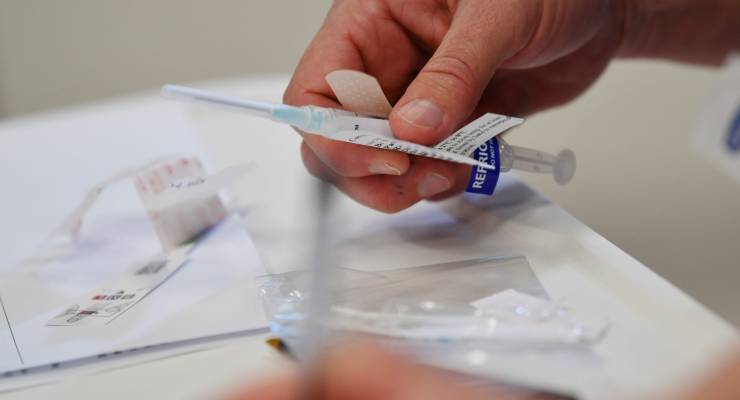
Accredited GP clinics and community pharmacies can register to administer COVID-19 vaccines when the mass rollout kicks off next month. But doling out doses isn’t as easy as it sounds.
Patients must be observed for 30 minutes after the injection — double the time for a normal flu injection — and there’s a lot of paperwork and follow-up required to ensure doses are administered on time and logged correctly.
Experts and industry bodies are concerned about pharmacies’ and clinics’ ability to do so and some say the government payment doesn’t cover the high administrative costs.
Vaccines are poorly recorded by pharmacists
Most Australians will receive the AstraZeneca or Pfizer vaccine. Both require two doses administered 28 and 21 days apart respectively. The shots are legally required to be logged with the Australian Immunisation Register and this record will be made available on the MyGov website or the Express Plus Medicare app which people can access on their smartphone.
Doctors will be paid $30.75 for the first injection and $24.45 for the second, with an additional $10 incentive for practices to ensure both shots are delivered at the one surgery.
Metropolitan pharmacies will be paid $16 for each dose plus the $10 incentive, and those in rural areas will get $19 a dose, again with the $10 incentive.
Proof of inoculation could be needed for international travel and workplaces and could even become a condition of entry to public spaces or events.
But pharmacists are notoriously bad at logging jabs with the register, a report from the National Centre for Immunisation Research and Surveillance shows.
In 2018 they reported administering more than a million influenza vaccinations but logged just one-tenth of them. It got a little better in 2019 with 2 million vaccinations reported and half a million logged.
That’s not to say doctors are much better: while vaccines given to children are generally well reported, another study found only half of all shingles vaccines administered were recorded with the register.
GPs are better-placed
Royal Australian College of General Practitioners president Dr Karen Price tells Crikey GPs should be the first port of call for the vaccine.
“Patients Australia-wide are used to going to their GP for vaccinations,” she said. “We have the appropriate medical training and setting for vaccinations, as well as existing links to the [Australian Immunisation Register].
“GPs are also experienced in talking to our patients if they have concerns, ensuring consent and building vaccine confidence.”
Price says clinics already have automated text messaging systems to remind people to get their second dose and are prepared for a “surge” coming forward to get the vaccine.
To make sure things run smoothly and vaccines are available in rural clinics and centres in diverse communities, more funding was needed.
“From the outset we have argued that this is not a standard vaccination program given all of the clinical, logistical and administrative costs associated,” Price said.
“The government’s current funding model is primarily suitable for mass vaccination clinics and may not be suitable for smaller clinics in both metro and rural areas who are already running at capacity.”
Incentives needed for pharmacists
National Centre for Immunisation Research and Surveillance epidemiologist Kaitlyn Vette tells Crikey more needed to be done to encourage Immunisation Register records. Providing funding was a start.
“[Pharmacies] haven’t been eligible to receive payments for reporting,” she said.
Funding was provided when vaccines are rolled out through national immunisation programs but these are generally for vaccines given to children, which pharmacists usually can’t administer.
Promoting the use of software which can automatically log vaccines was a good next step, she says.
“The majority of pharmacy vaccinations are still being reported manually, or they were in 2019,” she said.
“An obvious step in increasing reporting would be enabling or facilitating the automation of [Australian Immunisation Register] reporting through any software used to record vaccination … [and] making sure that reporting is as fast and simple as possible.”
Vette says pharmacists had to undergo accredited immunisation provider training, which includes addressing patients’ concerns and vaccine hesitancies.
“Pharmacists are well-qualified health professionals in their own right and I think there are good prerequisites in all jurisdictions for pharmacy immunisation providers, including CPR, first aid anaphylaxis management,” she said.
Pharmaceutical Society of Australia’s national president Associate Professor Chris Freeman has advocated for pharmacists to administer the vaccine.
“Pharmacists are more than capable, qualified and willing to provide this service to ensure the large-scale rollout of the COVID-19 vaccine,” he said.
The Pharmacy Guild of Australia tells Crikey it was still assessing the training for delivering the vaccinations and gauging its members’ response.








Crikey is committed to hosting lively discussions. Help us keep the conversation useful, interesting and welcoming. We aim to publish comments quickly in the interest of promoting robust conversation, but we’re a small team and we deploy filters to protect against legal risk. Occasionally your comment may be held up while we review, but we’re working as fast as we can to keep the conversation rolling.
The Crikey comment section is members-only content. Please subscribe to leave a comment.
The Crikey comment section is members-only content. Please login to leave a comment.